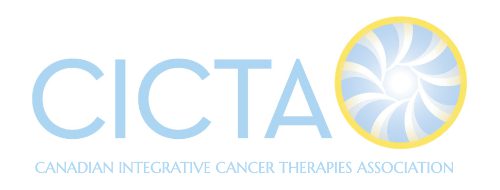Tsu-Tsair Chi, PhD
ABSTRACT
Angiogenesis inhibition has been a major breakthrough in cancer research and is undoubtedly one of the reasons for the decline in cancer incidence and mortality. In cases of estrogen-related cancers, the use of aromatase inhibitors has been quite successful in reducing recurrence and improving overall survival even after the treatment has ceased. This paper recommends that the combination of angiogenesis inhibitors and aromatase inhibitors has merit in targeting estrogen-related cancer. Furthermore, this paper presents compelling data and case reports of the use of a sea cucumber extract and an herbal formula as a potential angiogenesis inhibitor and an aromatase inhibitor, respectively.
KEY WORDS Aromatase inhibition; Angiogenesis inhibition; Receptor tyrosine kinase; Cancer; Natural supplements
INTRODUCTION
Cancer mortality rates have been steadily decreasing in the past several years. This is partly due to more sophisticated screening procedures and tests. A more significant contributing factor to these declining rates is the advances in cancer treatment modalities. Among these modalities are two types of therapy that have been the focus of cancer research and clinical trials and have shown major progress in increasing cancer survival: angiogenesis inhibition and aromatase inhibition.
Angiogenesis undoubtedly plays a major role in the development and growth of cancer, especially solid tumors. Research has shown that angiogenesis inhibitors effectively block the growth of tumors by cutting off their nutrient and blood supply. The mechanism by which they block tumor growth is driven by the inhibition of receptor tyrosine kinases (RTKs) that are overexpressed by cancer cells.
Aromatase expression promotes estrogen production, especially at the site of estrogen responsive tumors such as in breast, ovarian1,2 and prostate cancer3,4. Aromatase inhibitors seek to block the aromatase enzyme from converting androgens into estrogen. This will diminish estrogen production, eventually leading to tumor suppression and apoptosis.
The combination of angiogenesis and aromatase inhibitors as therapy for cancer of the breast, ovary, and prostate is a logical approach. With this type of approach, these hormone-related cancers are being attacked from different angles. New blood vessel formation from the tumor is being blocked by the angiogenesis inhibitor while the aromatase inhibitor limits the amount of estrogen that is feeding the growth of the tumor.
Two natural supplements show a very promising future as natural aromatase and angiogenesis/RTK inhibitors. An herbal combination containing the extracts of Cyperus, and Curcuma has been shown to inhibit aromatase in vitro and in vivo. Furthermore, it has been used effectively for cysts and fibroids in humans 5. A sea cucumber extract has exhibited in vitro and in vivo anti-angiogenic properties6-10. It is worth exploring the benefits of these natural supplements mainly due to promising results of in vitro, in vivo, and human studies.
Herbal Extracts: Aromatase Inhibitor
The aromatase enzyme contributes to the production of estrogen through two pathways: androstenedione to estrone and testosterone to estradiol (Figure 1). By inhibiting these two pathways, estrone and estradiol (both carcinogenic forms of estrogen) levels are reduced and the production of estriol, the good estrogen, remains unhindered. This is especially important in men because, as they get older, an increasing amount of testosterone is being converted into estradiol, leading to problems such as prostate cancer and decreased libido. Those who are using progesterone supplements should also be aware that the hormone can eventually be synthesized into estradiol and estrone (Figure 1) and create problems. An aromatase inhibitor can indirectly prevent estrogen production from this source.
The Herbal Extracts have been shown to inhibit the aromatase enzyme and consequently reduce estrogen levels. In an in vivo study on rat endometrial and ovarian tissues, the Herbal Extracts were shown to reduce aromatase expression tremendously after 28 days of administration by 100% and 85.6%, respectively, compared to the negative control group (Table 1)5.
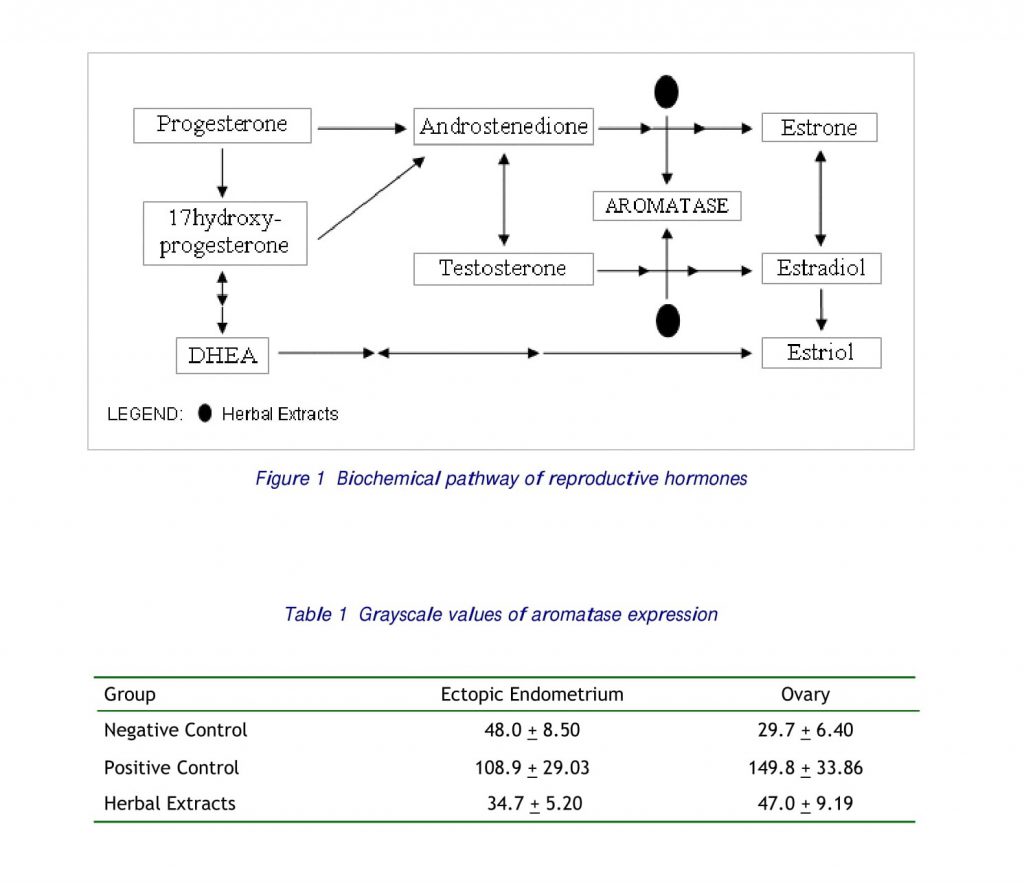
In one study, the estrogen-reducing action of the herbal extracts was evident on postmenopausal women with fibroids and cysts. Sixty women were involved with an average estradiol (the most potent form of estrogen) level of 74.52 pg/ml. After 10 days on the Extracts, their average estradiol level reduced to 38.84 pg/ml. The size of the fibroids/cysts, as well as the pain associated with them, was also diminished5.
Another study illustrates that the herbal extracts are effective in cysts, another estrogen-mediated condition. This study involved 85 pre- and postmenopausal women with ovarian cysts. After 1 to 3 months of taking the Herbal Extracts, the cysts, and symptoms of 15 patients completely cleared with no recurrence 3 months after the study while 34 women experienced a 50% reduction in the size of the cyst5.
Inhibiting aromatase and reducing estrogen levels do have a significant effect on estrogen-mediated growths, as illustrated in the following study. Fifty cases of fibrocystic breasts (45 women and 5 men) were given the Herbal Extracts for one month. Sixty five percent of the women were under 35 years old. In 14 cases, the growth cleared completely while the fibrocystic breast reduced by 50% in 16 cases. Of the five men in the study, the cyst cleared completely in 3 cases5.
In 1994, another study was conducted at the same hospital on 255 women with ovarian cyst and endometriosis. After 5 months, the Herbal Extracts were found to be effective on 147 patients (57.6%). Some improvement was observed on 87 patients while only 21 patients did not experience any effect.
Sea Cucumber Extract: Angiogenesis/RTK inhibitor
Sea Cucumber Extract contains the active ingredient Philinopside A, which has been shown through various studies to inhibit four different RTKs: vascular endothelial growth factor receptor (VEGFR), epidermal growth factor receptor (EGFR), platelet-derived growth factor receptor (PDGFR)and fibroblast growth factor receptor (FGFR)6,7. The number of RTKs it targets is significant because angiogenesis, or new blood vessel formation, is a complex process that involves multiple RTK signaling pathways. Inhibiting more than one RTK may prove to be more effective in blocking angiogenesis and other processes involved with cancer than inhibiting a single RTK (Figure 2).
The VEGFR is of particular importance because VEGF is specifically associated with vascularity and is highly expressed in solid tumors such as breast and prostate cancer. Results of clinical trials indicate that addition of a VEGFR inhibitor to standard cancer therapy produces better survival rates than standard cancer therapy alone. Even when given by itself, a VEGFR inhibitor produces better results on patients with no prior treatment8.
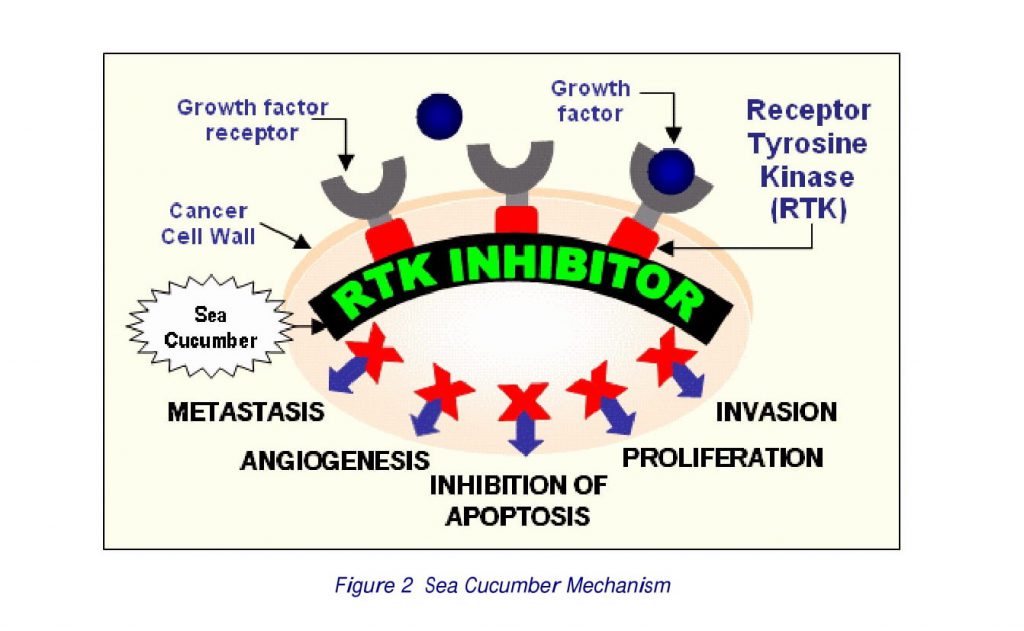
In studies, Sea Cucumber Extract was shown to inhibit VEGFR with an IC50 of 2.6mM, comparable to that of SU5416 (semaxanib), a selective VEGFR inhibitor drug with an IC50 of 2.9mM9. Furthermore, it inhibits VEGFR’s associated downstream signaling pathways: Akt, FAK, Paxillin and ERK7. Each of these signals is responsible for different aspects of angiogenesis. The Akt signal regulates cell survival and is therefore crucial to the apoptosis of cancer cells. Both FAK and paxillin play important roles in cell adhesion and migration. ERK regulates mitogenesis. Inhibiting these downstream signals is vital to fully suppressing VEGFR. This means that angiogenesis can be effectively stopped, cutting off nutrient and blood supply to the tumor and eventually inducing apoptosis.
Sea Cucumber Extract’s effect on angiogenesis was evident in the case of a 42-year-old woman from Florida who tested positive on a mammogram and ultrasound (Figure 3a). Through thermal imaging performed by Medi-Therm Imaging, angiogenesis evidently increased around the tumors from April to June 2005 (Figure3b), during which time she did not undergo any type of treatment. Beginning June 28, 2005, she took Sea Cucumber Extract, and the result has been remarkable. It appears that angiogenesis has significantly receded after two months of taking Sea Cucumber Extract (Figure 3c).
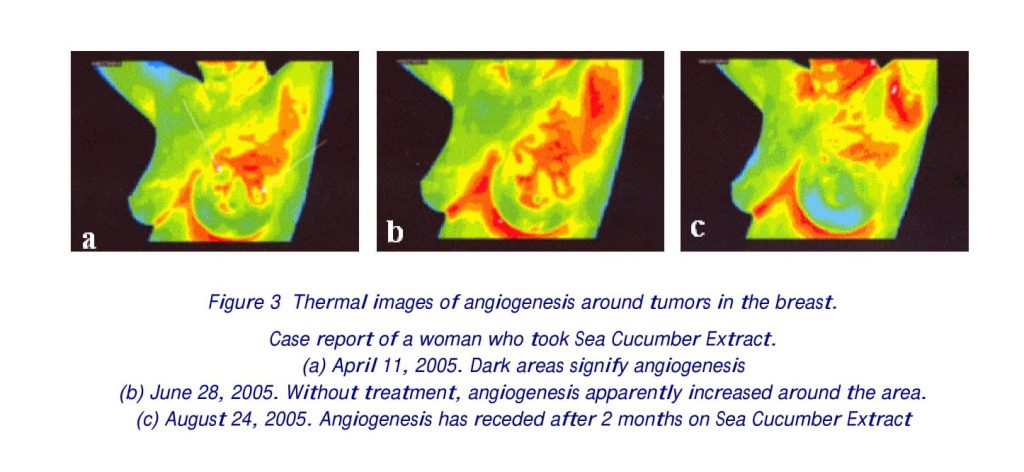
Further studies support Sea Cucumber Extract’s anti-angiogenesis activity in vivo. Two mouse models were employed: one with tumors induced by implanting sarcoma 180 cells, the other with tumors induced by hepatoma 22 cells. Administration of Sea Cucumber Extract for 7 days at concentrations of 2, 3 and 4 mg/kg inhibited sarcoma 180 tumor growth by 28.2, 55.6, and 60.7%, respectively. In the other group, administration of 1, 2, and 3 mg/kg Sea Cucumber Extract for 7 days suppressed hepatoma 22 tumor growth by 20.6, 46.1 and 59.4%, respectively9.
In a new animal study, the effect of Sea Cucumber Extract and Mitomycin C (MMC), an antitumor drug, on prostate tumors was compared. The study involved 36 BALB/cA nude mice (40 to 45 days old, weighing 15 -16 g). The mice were divided into five groups. Group 1 was the negative control and given only a saline solution. Group 2 is the MMC group, given 5 mg/kg. Groups 3 through 5 were given Sea Cucumber Extract at doses of 10.4 mg/kg, 5.2mg/kg and 2.6 mg/kg, respectively. Prostate cancer (PC-3) cells were injected into the groin area of the mice, for three generations, until a tumor was formed. Then a tumor the size of 1.5 mm3 was implanted into each mouse under sterile conditions until the tumor grew to a volume between 100 to 200 mm3 (day 0). Doses of MMC and Sea Cucumber Extract were then administered intravenously every other day to their respective groups. After 28 days, the tumor volume (TV) was measured (day 28). The relative tumor volume (RTV) was then calculated for each group as well as the tumor regression rate (T/C). A lower the T/C rate indicates better anti-tumor activity.
It is evident from the results (Table 2) that Sea Cucumber Extract has a dosage-dependent antitumor activity against prostate cancer. Its T/C rate (39.2%) at the dose of 10.4 mg/kg is almost comparable to that of MMC (38.9%).
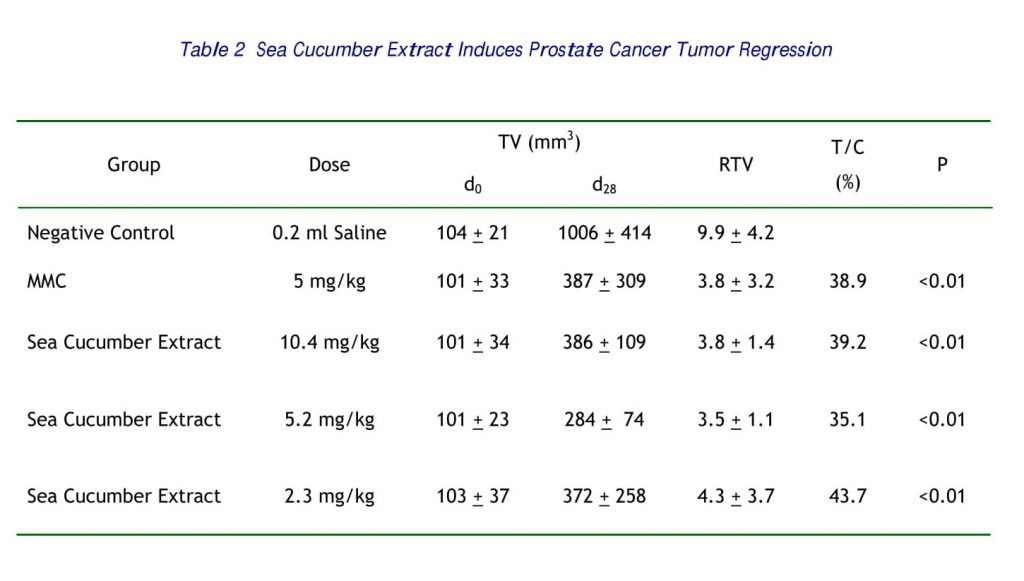
Sea Cucumber Extract has exhibited an effect on prostate cancer in at least one case. A 53-year-old prostate cancer patient from Virginia had a Prostate Specific Antigen (PSA) level of 12. Needle biopsies in two areas of his prostate revealed high-grade Prostatic Intraepithelial Neoplasia. After approximately seven months on Sea Cucumber Extract, the Herbal Extracts and Asparagus Extract, another biopsy showed that the neoplasia has disappeared, and his PSA dropped to 6. In October 2006, approximately 12 months after he started his regimen, his PSA further reduced to 3.06.
The growth of tumors in the prostate and other areas is largely dependent on new blood vessel formation. This explains the significant role of VEGF especially during the early stages of tumor development. However, cancer progression is associated with multiple signaling pathways. For instance, the PDGFR signaling pathway also plays a role in cell proliferation, cell migration and angiogenesis. Blocking this pathway has been demonstrated to inhibit angiogenesis and tumor vascularization and maintenance. The EGFR pathway is another signaling factor that is worth considering. This signaling is involved in mitogenesis, apoptosis and cellular motility10-11. Therefore, inhibiting EGFR can contribute to preventing the spread of the cancer cells. Like EGFR, the FGFR pathway is also involved in proliferation, apoptosis, mitogenesis and angiogenesis. Blocking FGFR not only prevents the spread of the cancer but also with blocking new blood vessel formation12.
It is therefore not surprising that simultaneous inhibition of multiple signaling pathways has been demonstrated to be more effective than inhibiting a single RTK. In studies performed on mice, inhibiting VEGFR alone was effective only in the initial stages of angiogenesis. Inhibiting both VEGFR and PDGFR significantly diminished the size of tumors and reduced vasculature of end-stage tumors10. This is why a wide spectrum RTK inhibitor like Sea Cucumber Extract is more beneficial, because it targets multiple signaling pathways (VEGFR, PDGFR, EGFR, and FGFR), effectively counteracting cancer growth in many aspects. It has also shown an inhibitory activity against topoisomerase in preliminary studies. If this function becomes established, Sea Cucumber Extract will become an even more effective cancer therapy agent.
DISCUSSION
Inhibiting RTKs can be very effective in many types of cancer. But for estrogen-related cancer, such as breast and prostate cancer, addition of an aromatase inhibitor may prove to be a more effective regimen because many aspects of the cancer are being targeted at the same time. First, the formation of blood vessels that feed the tumor is prevented. Second, by precluding the action of aromatase, estrogen production is greatly diminished, helping prevent the proliferation of tumor cells.
Treatment with either an angiogenesis or an aromatase inhibitor by itself certainly has merit. But combining both therapies, particularly for estrogen responsive diseases like breast and prostate cancer, has such tremendous potential success that it should be considered as a standard combination of treatment.
Reiterating what was mentioned in an earlier section, this combination of therapies deals with many facets of breast and prostate cancer. Obviously, the growth of the tumor should be suppressed to prevent it from getting worse and spreading to other tissues. A multi-targeted angiogenesis inhibitor like Sea Cucumber Extract will manage that issue. By inhibiting multiple RTKs, it accordingly cuts off the nutrient and blood supply to the tumor and stops it from proliferating.
In the last decade, several RTK inhibitor drugs have been approved for treatment of different types of cancer. Among these are Avastin® (bevacizumab), a VEGFR inhibitor for colorectal cancer; Gleevec® (imatinib), which inhibits PDGFR and BCR-ABL for leukemia and gastrointestinal stromal tumor (GIST); Tarceva ® (erlotinib), an EGFR inhibitor for non small cell lung carcinoma and pancreatic cancer; Herceptin® (trastuzumab), an EGFR and HER2 inhibitor for breast cancer; and Sutent® (sunitinib), a multi-RTK inhibitor for GIST and advanced kidney cancer.
It is apparent that some types of cancer express different RTKs. For example, colorectal cancer expresses both VEGFR and EGFR. Breast cancer also expresses EGFR, HER2 and possibly VEGFR. Therefore, inhibiting one RTK may not be enough to completely suppress the tumor. A wide-range RTK inhibitor like Sea Cucumber Extract is more likely to produce better results in blocking angiogenesis and preventing invasion and metastasis. More clinical studies are certainly needed in order to elucidate its exact mechanisms; however, preliminary studies already show that Sea Cucumber Extract could be a potentially viable natural angiogenesis and RTK inhibitor.
Aromatase inhibition is another aspect targeted by the combinational therapy. A major portion of breast cancer cases are estrogen-responsive and will therefore benefit from treatments that reduce estrogen production: treatments such as aromatase inhibitors. In fact, aromatase inhibitors are considered “critically important” for improving breast cancer outcomes13. There are conflicting reports on the effect of hormones on prostate cancer. However, it is a fact that increased aromatase activity has been detected in malignant prostate cancer tissues. The role of aromatase inhibitors in prostate cancer treatment is certainly a basis for further exploration.
Conflicting reports notwithstanding, the importance of aromatase inhibitors in the treatment of hormone-related conditions has gained momentum in the past few years. Evidence supports that aromatase inhibitors are vital for improving breast cancer treatment outcomes. Long-term use appears to produce better results14. The increasing use of aromatase inhibitor drugs such as Arimidex® (anastrozole), Aromasin® (exemestane) and Femara® (letrozole) is testament to their effectiveness. The drawback to these drugs, however, is that they are all indicated for postmenopausal women only, not for men or for premenopausal women.
The Herbal Extracts, on the other hand, have been used by men as well as pre- and postmenopausal women, as indicated by the studies. This is perhaps more clearly evident in the results of the studies on men and women with fibrocystic breasts. In three of the five men in the study, their cysts cleared completely. In that same study, 65% of the women were under 35 years old, demonstrating that this herbal formula is not only limited to postmenopausal women. Further studies are certainly warranted to find out the Herbal Extracts’ effect after long-term use. However, the studies presented here show that short-term use of the Herbal Extracts does have some therapeutic effects.
In recent years, aromatase inhibitors have been more widely used than other hormone-related therapy for breast cancer. Antagonizing the effect of estrogen used to be the main objective of these therapies rather than lowering estrogen levels. Most notable among drugs with this mechanism are Tamoxifen®. Recent studies, however, have shown that long-term use of Tamoxifen® provides no apparent benefits. Aromatase inhibitors, on the other hand, produce better long-term effects and improve quality of life13. In particular, the five-year ATAC trial showed that an aromatase inhibitor produced better results than Tamoxifen®. It prolonged disease-free survival, reduced recurrence, reduced distant metastases and lessened contralateral breast cancer. The aromatase inhibitor also had fewer side effects than Tamoxifen14.
In light of these results, the use of an aromatase inhibitor like the Herbal Extracts for estrogen related cancers has even more merit. With the addition of an angiogenesis and RTK inhibitor such as Sea Cucumber Extract, the benefits are even more potentially favorable. Some researchers have found that estrogen increased VEGF levels in normal breast tissue, promoting angiogenesis15. Further investigation is certainly warranted to establish the direct link between estradiol and VEGF. But if this is indeed true, then the use of an angiogenesis and aromatase inhibitor is even more imperative to achieve more comprehensive and effective results.
REFERENCE
1. Suzuki T, Miki Y, Moriya T, Akahira J, Hirakawa H, Ohuchi N, Sasano H. Sex steroid-producing enzymes in human breast carcinoma. Med Mol Morphol. 2007; 40(3):121-7.
2. Nakamura J, Imai E, Yoshihama M, Sasano H, Kubota T. Histoculture drug response assay, a possible examination system for predicting the antitumor effect of aromatase inhibitors in patients with breast cancer. Anticancer Res. 1998; 18 (1A):125-128.
3. Ellem SJ, Schmitt JF, Pedersen JS, Frydenberg M, Risbridger GP. Local aromatase expression in human prostate is altered in malignancy. J Clin Endocrinol Metab. 2004; 89(5): 2434-2441.
4. Ellem SJ, Risbridger GP. Aromatase and Prostate Cancer. Minerva Endocrinol. 2006 Mar; 31(1):1-12.
5. Chi TT. Combination of Chinese herbs acts as an aromatase inhibitor for estrogen-related conditions. ANMA Monitor. 2006 Apr; 10(2).
6. Tong Y, Zhang X, Tian F, Yi Y, Xu Q, Li L, et al. Philinopside A, a novel marine-derived compound possessing dual anti-angiogenic and anti-tumor effects. Int J Cancer. 2005; 114:843-53.
7. Tian F, Zhang X, Tong Y, Yi Y, Zhang S, Li L, et al. PE, a New sulfated Saponin from Sea Cucumber, Exhibits Anti- Angiogenic and Anti-Tumor Activities in vitro and In Vivo. Cancer Biol Ther. 2005 Aug; 4(8):874-882.
8. May 2005. Annual Meeting of the American Society of Clinical Oncology.
9. Chi TT. Benefits of a sea cucumber extract in anti-angiogenic therapy and RTK inhibition for cancer. Townsend Lett. 2006 Aug/Sep: 91-95.
10. Bergers G, Song S, Meyer-Morse N, Bergsland E, Hanahan D. Benefits of targeting both pericytes and endothelial cells in the tumor vasculature with kinase inhibitors. J Clin Invest. 2003; 111:1287-1295.
11. Erber R, Thurnher A, Katsen AD, Groth G, Kerger H, Hammes HP, et al. Combined inhibition of VEGF and PDGF signaling enforces tumor vessel regression by interfering with pericyte-mediated endothelial cell survival mechanisms. FASEB J. 2004; 18:338-340.
12. Kwabi-Addo B, Ozen M, Ittmann M. The role of fibroblast growth factors and their receptors in prostate cancer. EndoRel Cancer. 2004; 11 (4) 709-724.
13. Breast International Group (BIG) 1-98 Collaborative Group, Thürlimann B, Keshaviah A, Coates AS, Mouridsen H, Mauriac L, et al. A comparison of letrozole and tamoxifen in postmenopausal women with early breast cancer. NEJM. 2005; 353:2747-57.
14. ATAC Trialist’s Group, Forbes JF, Cuzick J, Buzdar A, Howell A, Tobias JS, et al. Effect of anastrozole and tamoxifen as adjuvant treatment for early-stage breast cancer: 100-month analysis of the ATAC trial. Lancet Oncol. 2008; 9(1):45-53.
15. Garvin S, Nilsson UW, Huss FR, Kratz G, Dabrosin C. Estradiol increases VEGF in human breast studied by wholetissue culture. Cell Tissue Res. 2006 Mar 28.
Correspondence to:
Chi’s Enterprise, Inc.
1435 N. Brasher Street
Anaheim, California, 92653 USA
Telephone: (714) 777-1542
Fax: (714) 777-7186
Email: veinlite@mindspring.com
